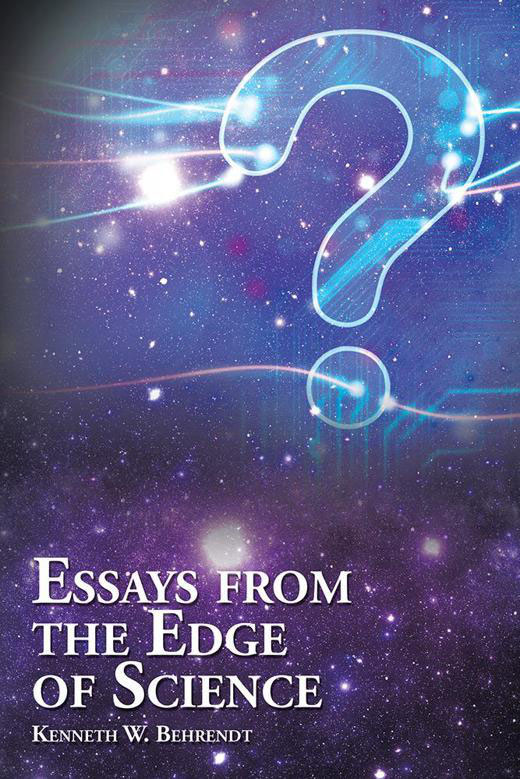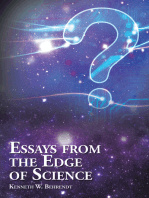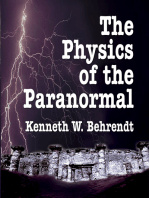Kenneth W. Behrendt - Essays from the Edge of Science
Here you can read online Kenneth W. Behrendt - Essays from the Edge of Science full text of the book (entire story) in english for free. Download pdf and epub, get meaning, cover and reviews about this ebook. genre: Religion. Description of the work, (preface) as well as reviews are available. Best literature library LitArk.com created for fans of good reading and offers a wide selection of genres:
Romance novel
Science fiction
Adventure
Detective
Science
History
Home and family
Prose
Art
Politics
Computer
Non-fiction
Religion
Business
Children
Humor
Choose a favorite category and find really read worthwhile books. Enjoy immersion in the world of imagination, feel the emotions of the characters or learn something new for yourself, make an fascinating discovery.
- Book:Essays from the Edge of Science
- Author:
- Genre:
- Rating:4 / 5
- Favourites:Add to favourites
- Your mark:
- 80
- 1
- 2
- 3
- 4
- 5
Essays from the Edge of Science: summary, description and annotation
We offer to read an annotation, description, summary or preface (depends on what the author of the book "Essays from the Edge of Science" wrote himself). If you haven't found the necessary information about the book — write in the comments, we will try to find it.
Essays from the Edge of Science — read online for free the complete book (whole text) full work
Below is the text of the book, divided by pages. System saving the place of the last page read, allows you to conveniently read the book "Essays from the Edge of Science" online for free, without having to search again every time where you left off. Put a bookmark, and you can go to the page where you finished reading at any time.
Font size:
Interval:
Bookmark:

ESSAYS FROM THE EDGE OF SCIENCE
KENNETH W. BEHRENDT

AuthorHouse
1663 Liberty Drive
Bloomington, IN 47403
www.authorhouse.com
Phone: 1 (800) 839-8640
2015 Kenneth W. Behrendt. All rights reserved.
No part of this book may be reproduced, stored in a retrieval system, or transmitted by any means without the written permission of the author.
Published by AuthorHouse 04/28/2015
ISBN: 978-1-5049-0759-0 (sc)
ISBN: 978-1-5049-0757-6 (e)
Any people depicted in stock imagery provided by Thinkstock are models,
and such images are being used for illustrative purposes only.
Certain stock imagery Thinkstock.
Because of the dynamic nature of the Internet, any web addresses or links contained in this book may have changed since publication and may no longer be valid. The views expressed in this work are solely those of the author and do not necessarily reflect the views of the publisher, and the publisher hereby disclaims any responsibility for them.
T HIS IS NOT THE BOOK I had intended to be my fifth published work. Rather, I had intended to do a book about an early 18 th century craftsman / inventor named Johann Ernst Elias Bessler and the marvelous inventions he had created such as working perpetual motion wheels! However, the research I had been conducting into the internal mechanics of his wheels was not yet complete and ready for presentation and several years had already passed since my last work, The New Science of the UFO , had appeared. So, in order not to disappoint those who may have been following my writings over the years, I decided to produce the present volume.
In this book the reader will find a somewhat unusual collection of what may be referred to as New Age writings on subjects that range from the strange powers of various animal species on and below our Earths surface to ghosts to religions to UFOs and on to the big picture when it comes to understanding the ultimate nature of the cosmos we inhabit. (Theres even a final chapter that presents a system for playing and, hopefully, winning state Lotto games! Its inclusion was a last minute decision for reasons that are given at its beginning.)
Much of the material is somewhat old, but has been carefully rewritten, updated, and expanded. Some of it is new and should appeal to the more technically minded reader.
My goal is to impress upon the general reader that current science is still a long way from being complete in any true sense of the term. It is, as it has always been, provisional in nature and subject to revision whenever new data from experiments and observations is available that contradicts previously accepted theories. Change, however, does not come easily to any human endeavor, especially science.
For example, Lord Kelvin, the greatest scientist of the 19th century, declared in 1899 that the science of his day was complete and that nothing new would be added to it other than more precise measurements due to improvements in instrumentation. Little could he know then what massive changes would come to the world of physics when the works of such notables as Niels Bohr and Albert Einstein appeared only a few years later. Their research was eventually accepted as valid, but only after much debate and opposition.
No doubt the material presented in this volume will also be dismissed by the current world of science as just so much fantasy. However, I remain highly confident that most of the material contained herein, particularly that which is more technical in nature, will be found in our university physics textbooks (or their digital equivalents) by the end of this 21st century and, perhaps, much sooner in certain cases. Thus, the reader should consider this volume as a sort of crystal ball that will give him or her an advanced look into what future science will look like.
As with all of my works, I advise the reader to start at the beginning and work his way through the chapters of the book in the order in which they are presented. This is because I always try to arrange material so that it builds upon itself. If one reads the chapters out of their intended order, he may encounter material that involves concepts developed in earlier chapters with which he is not yet familiar and then confusion can result.
Hopefully, the reader will, by the time he completes this volume, be impressed that we live in a world wherein there is real magic occurring which is still just beyond the edge of currently known and accepted science. Soon the physics of that magic will be understood completely and as a result we will see major paradigm shifts taking place in science and philosophy which will then quickly affect, most likely for the better, practically every aspect of human life on our planet and its relationship to the rest of the cosmos.
I WAS A CHILD WHEN I had my first experience with an intelligent animal. It happened on one of several weekend sleepover visits that my parents would take me along on when they visited an aunt of mine that lived in a neighboring state. She owned a most remarkable male collie that was named Duke or, more affectionately, was just called Dukie. I always looked forward to those visits to my aunts home because I loved playing with her dog. The reason was that he had a most unusual ability which I have never seen any other dogs display. Dukie apparently understood English to a degree which almost made him seem human!
For example, if I told Dukie to follow me, he would and remain within a few feet of me at all times. If I told him to go up or down the stairs by himself, he would. And, if he was anywhere in the house and I called him, he would immediately be at my side. His ability to understand English became most apparent when he was instructed to fetch an item. I could tell him to bring me a ball, slipper, or newspaper and he would. If he brought the wrong item and I said No, thats not right, he would immediately return it to its original location and continue to select other items until he got it right.
I remember one incident, in particular, when I noticed that he seemed to have a limitation in his abilities. While he could discern differences between the sizes and shapes of objects, he could not tell the difference between their colors. Once, there were two sponge rubber balls that I had brought with me. One was red and the other blue in color. Dukie seemed unable to tell the difference between them when he was asked to fetch one of a particular color. It was only in later life that I finally learned why. The reason was that dogs, for some strange reason, lack the retinal cells in their eyes that would allow them to perceive colors. It is thought that this may stem from their evolution as nocturnal hunters whose vision must be more specialized for seeing in low light levels rather than for distinguishing between colors which, apparently, is easier to do during the daylight hours.
I believe that much of Dukies remarkable, almost human abilities, were due to the fact that my aunt raised him from a puppy and that he lived, unrestrained, in the house with her. Each night he would sleep at the foot of her bed. He had little interaction with other dogs and probably considered himself to be human!
Dukie had a long life and provided my dear aunt with many years of companionship. Eventually, as he grew feeble and incapacitated from age, it became necessary to have him put to sleep. He died in my aunts arms while organ music was played in the background and his passing was something that deeply affected all of us for many months afterwards.
Next pageFont size:
Interval:
Bookmark:
Similar books «Essays from the Edge of Science»
Look at similar books to Essays from the Edge of Science. We have selected literature similar in name and meaning in the hope of providing readers with more options to find new, interesting, not yet read works.
Discussion, reviews of the book Essays from the Edge of Science and just readers' own opinions. Leave your comments, write what you think about the work, its meaning or the main characters. Specify what exactly you liked and what you didn't like, and why you think so.











